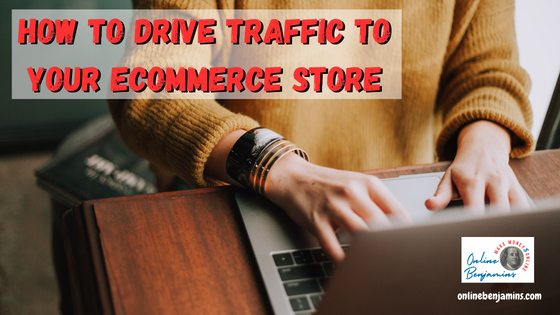Do you have an ecommerce business? Or, are you thinking of starting one? One of the most important factors in your success will be how to drive traffic to your ecommerce store. If you want to be successful you need to think of your ecommerce store as a digital store.
And, similar to a traditional offline bricks-and-mortar business, you need to attract people to your store. Without the right strategies to attract and direct people through your digital doors, even the best products remain unseen and unsold. Follow along and we’ll walk you through how to increase your ecommerce store’s foot traffic — digitally speaking, of course.
KEY POINTS: 4 Strategies to Drive Traffic to Your Ecommerce Store
- Find out which social media platforms your potential customers frequent and build a profile and presence there for your store
- Optimize your ecommerce store for search engines with proper tags, descriptions, keywords, images, and backlinks
- Add a blog to your ecommerce store’s website and practice content marketing by providing interesting and helpful content to your visitors.
- Gather visitor/customer emails to build an email list to start an email marketing campaign. Use it to inform and connect with customers and encourage repeat buyers.
We will intertwine the principles of E-E-A-T — experience, expertise, authoritativeness, and trust — with strategies designed to drive traffic to your online store. By focusing on providing value and building credibility, the content on your site isn’t just attractive to people, but also to search engines that prioritize helpful information.
At the heart of this intersection is an undeniable truth: exceptional customer experience coupled with effective search engine optimization (SEO) lays a strong foundation for driving store traffic. Give customers a seamless, enriching online shopping journey, and they will not only come but also likely return with friends.
The process of attracting visitors is nuanced, but when performed well, it leads to a thriving ecommerce business. First, let’s set the stage with your social media presence. It’s more than just a megaphone for announcing sales; it’s a golden opportunity to create meaningful connections with potential customers and drive engagement, the first step in a multi-layered approach to increase traffic.
Social media isn’t just a playground for the latest memes and trends. It’s a potent tool for ecommerce, a bridge connecting your store to individuals glued to their screens. I’ve seen firsthand how choosing the right platforms is the cornerstone of social media success.
Your store doesn’t need to be everywhere—just where your potential buyers are. Learn which platforms your potential customers hang out on and build your store’s presence.
At its core, this is about creating shareable content. It’s about hitting that sweet spot where your products meet real human stories, needs, and desires. People crave this authenticity.
They want to see how your items fit into their lives, not just on a warehouse shelf. Developing authentic, engaging posts can not only increase your tribe but also encourage shares, extending your reach.

Paid promotions on these platforms offer a precision that traditional advertising can miss. By targeting specific demographics and interests, you place your products in the sightline of those who are most likely to buy. It’s not just about scattering seeds; it’s about planting them where they’ll thrive.
But remember, it’s not a one-way street. Responding to comments, and messages, and engaging directly with your community turns followers into advocates. It’s about building connections that foster trust—because when people trust you, they’ll want to shop with you.
SEO and Optimizing Your Store for Search Engines
You know your ecommerce store offers great products, but if potential customers can’t find you online, your efforts are akin to whispering in a windstorm. That’s where search engine optimization, or SEO, comes in as your megaphone. By adhering to SEO best practices, your store becomes more visible to those looking for what you sell.
Ecommerce SEO starts with on-page optimization. This includes using the right keywords in your product titles, descriptions, and meta tags, all without stuffing them indiscriminately. It simplifies the search engines’ job of categorizing your pages correctly and then serving them up to people looking for products you offer.
But SEO isn’t just about keywords. It’s the total package, from URLs that describe your page contents to ensuring every image has an ALT text that explains what’s shown. Your site structure also matters; a clear hierarchy helps both search engines and shoppers navigate with ease.
To learn more about Ecommerce, SEO, and building your own online business, check out the platform I use to build my businesses and make money online. Grab their No-cost, No obligation trial so you can try it before you buy it. You have absolutely nothing to lose.
Then there’s the often-overlooked off-page SEO. It revolves around building a web of trust through backlinks and social signals. Quality backlinks from reputable websites tell search engines that your store is credible and deserves a higher rank.
Perhaps the most critical SEO factor is the user experience (UX). A store that loads quickly, displays nicely on mobile devices, and offers intuitive navigation encourages users to stay longer and engage more. And search engines take notice.
We can’t forget mobile optimization. With smartphones being a prime shopping tool, your mobile storefront needs to be as efficient and appealing as your desktop version. Fast page loads, responsive design, and easy checkouts are non-negotiables here.
But remember, no amount of SEO can replace the basics: high-quality products, competitive prices, and excellent customer service. By combining these elements with a robust SEO strategy, you set the stage for increased, sustainable web traffic.
Investing in Content Marketing with Blogging
Picture this: you enter a store only to find rows of products with price tags, devoid of any character or information. That’s a brick-and-mortar analogy for an ecommerce site without rich content. I’m here to show you why investing in content marketing is crucial for your ecommerce store and how it can transform your customer’s experience.

Start with a blog. It’s a space not just for product announcements but for sharing stories and how-to guides, and to provide solutions that your audience is actively seeking. Educating your reader establishes your store as a thought leader, a trusty advisor instead of a mere seller. This fosters that crucial element – trust. You already have a website (ecommerce store) so adding a blog to it is a simple matter.
Quality content is a pillar of the E-E-A-T strategy. An article that aids in solving a problem signals to your audience and to search engines that your site is an authority worth visiting. Additionally, rich and in-depth content enhances the experience for your visitors, encouraging them to stay longer and engage more.
But it’s not just about the written word. Videos demonstrating product use or customer testimonials, images that tell a story, and infographics simplifying complex information all enrich the user’s journey. This diversity also increases the chance to rank in search engines, as they love multimedia content that enhances user experience. Consider starting a YouTube channel for your ecommerce business. It’s free and can be an excellent source of buyer traffic.
Finally, don’t let your content gather dust. Share it on social channels, newsletter features, or even partnerships with influencers and industry leaders. Leverage these networks to reach more eyes and drive traffic back to your store. Remember, content marketing isn’t a one-way street; it’s about creating conversations and building relationships.
Now, imagine blending these content strategies with the personal touch of email marketing. That’s where we head next, as you craft emails that speak directly to your customers’ needs, driving traffic and fostering loyalty.
Follow Up with Email Marketing
Email marketing can be a very effective strategy for driving traffic to your ecommerce store. And, with effective email follow-up campaigns, you build rapport and trust with your customers encouraging them to become repeat customers. And, it is much easier to sell to a current, satisfied, customer than it is to recruit a new customer that is unfamiliar with you or your store.
You can collect customer emails through your blog, or even through the checkout process on your ecommerce store. You can encourage email signups through gifts or discount offers. Your email list is an extremely valuable commodity.
You can use emails to introduce new products to your list. You can send out notifications to your list whenever you post new content to your blog. You can even send out helpful emails that solve problems your customers may be experiencing and show them how your products are the solution they need.
Email marketing is a valuable tool to drive traffic to your ecommerce store and help you build a long-term and profitable online store. When combined with the other strategies we’ve discussed here today you will have a powerful traffic-generating machine that will put you ahead of your competition now and into the future.
Digital Foot Traffic to Stay Ahead in the Ecommerce Race
Driving traffic to your ecommerce store is not a one-time event but a continuous process. Success depends on your adaptability and willingness to evolve with changing consumer behaviors and market trends.
KEY TAKEAWAYS:
- To be successful in ecommerce it takes more than just good products and good service.
- You need an effective marketing campaign to drive potential customers to your digital storefront.
- Social media, Search Engine Optimization, Content Marketing, and Email Marketing can be very effective tools to drive traffic to your ecommerce store and keep you ahead of the competition.
It’s essential to keep a close eye on the effectiveness of your strategies. Use analytics tools to track visitors’ behavior, conversion rates, and overall performance. Understanding these metrics helps in making informed decisions and facilitates timely adjustments to your approach.
Technology and best practices in the ecommerce industry are always advancing. Commit to lifelong learning by staying abreast of the latest ecommerce trends, SEO updates, and traffic generation methods. This dedication not only aids in maintaining your competitive edge but also ensures that your store adheres to the principles of E-E-A-T.
Your customers are your most valuable source of insight. Actively seek out their feedback through surveys, social media, and review platforms. By listening to their preferences and concerns, you can enhance user experience, drive repeat traffic, and build a brand that resonates deeply with your audience.
Remember that driving traffic to your ecommerce store is an investment in your brand’s future. Focus on creating a seamless, informative, and enjoyable shopping experience, and your customers will reward you with their loyalty and advocacy. The journey to ecommerce success is ongoing. Be ready to adjust your sails as the digital winds change.
I’m Looking forward to working with you,

- onlinebenjamins.com
- thebeachangler.com
- thesinnerinthemirror.com
- my.wealthyaffiliate.com/rex10
- Facebook: Online Benjamins
- Twitter: @onlinebenjamin1
- Instagram: dotcomdinero
Rex
P.S. If you have any questions or are unsure of anything, I am here and I promise I will get back to you on all of your questions and comments. Just leave them below in the comment section. Follow me on Twitter: @onlinebenjamin1, Instagram: dotcomdinero, and Facebook: Online Benjamins
Hi,
Thanks for stopping by and congratulations for taking the first steps to building your own online business. I’ve been in business both offline and online since 1997. I would consider it an honor to help you build your business. Father of 3, life long outdoorsman with an education in Genetics and Economics. This site is about cutting through the BS and finding the real opportunities in the online world. I look forward to working with you.



